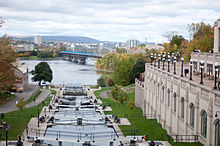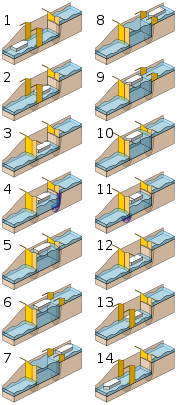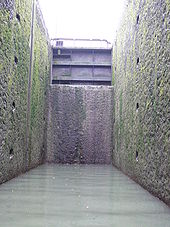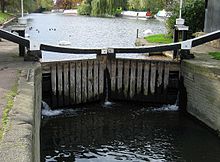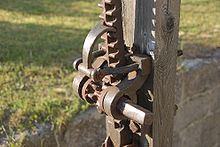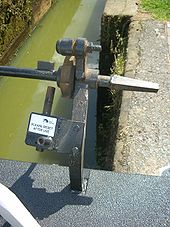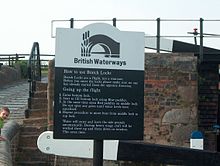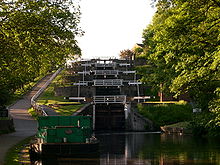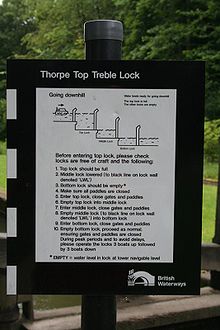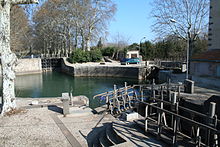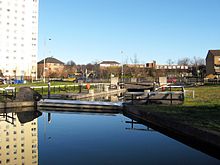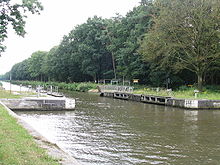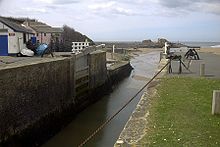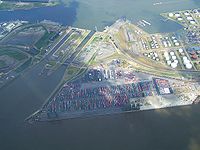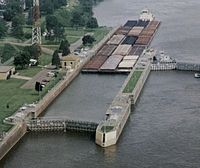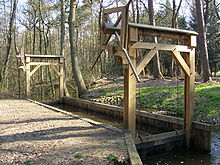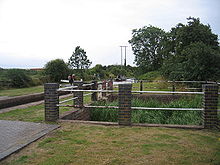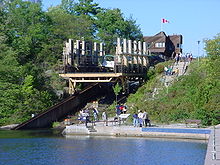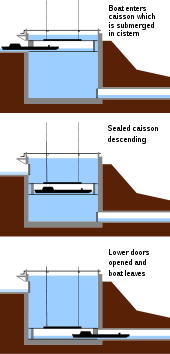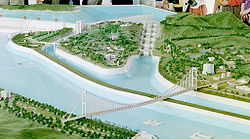- Lock (water transport)
-
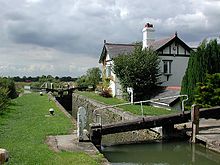 Canal lock and lock-keeper's cottage on the Aylesbury Arm of the Grand Union Canal at Marsworth in Hertfordshire, England
Canal lock and lock-keeper's cottage on the Aylesbury Arm of the Grand Union Canal at Marsworth in Hertfordshire, England
A lock is a device for raising and lowering boats between stretches of water of different levels on river and canal waterways. The distinguishing feature of a lock is a fixed chamber in which the water level can be varied; whereas in a caisson lock, a boat lift, or on a canal inclined plane, it is the chamber itself (usually then called a caisson) that rises and falls.
Locks are used to make a river more easily navigable, or to allow a canal to take a reasonably direct line across land that is not level.
Contents
Pound lock
A pound lock is a type of lock that is used almost exclusively nowadays on canals and rivers. A pound lock has a chamber (the pound) with gates at both ends that control the level of water in the pound. In contrast, an earlier design with a single gate was known as a flash lock.
Pound locks were used in ancient China during the Song Dynasty (960–1279 AD), having been pioneered by the government official and engineer Qiao Weiyo in 984.[1][2] They replaced earlier double slipways that had caused trouble and are mentioned by the Chinese polymath Shen Kuo (1031–1095) in his book Dream Pool Essays (published in 1088),[3] and fully described in the Chinese historical text Song Shi (compiled in 1345):[4]
The distance between the two locks was rather more than 50 paces, and the whole space was covered with a great roof like a shed. The gates were 'hanging gates'; when they were closed the water accumulated like a tide until the required level was reached, and then when the time came it was allowed to flow out.
The water level could differ by 4 or 5 feet at each lock and in the Grand Canal the level was raised in this way by 138 feet (42 m).[2][4]
In medieval Europe a type of pound lock was first built in 1373 at Vreeswijk, Netherlands.[5] This pound lock serviced many ships at once in a large basin, yet the true pound lock (i.e. one for a small basin) came in 1396 with the one built at Damme near Bruges.[5] A famous civil engineer of pound locks in Europe was the Italian Bertola da Novate (c. 1410-1475), who constructed 18 of them on the Naviglio di Bereguardo (part of the Milan canal system sponsored by Francesco Sforza) between the years 1452 and 1458.[6]
A lock is required when a stretch of river is made navigable by bypassing an obstruction such as a rapid, dam, or mill weir — because of the change in river level across the obstacle.
In large scale river navigation improvements, weirs and locks are used together. A weir will increase the depth of a shallow stretch, and the required lock will either be built in a gap in the weir, or at the downstream end of an artificial cut which bypasses the weir and perhaps a shallow stretch of river below it. A river improved by these means is often called a Waterway or River Navigation (see example Calder and Hebble Navigation).
The lowest lock on a navigable river separates the tidal and non-tidal stretches. Sometimes a river is made entirely non-tidal by constructing a sea lock directly into the estuary.
In more advanced river navigations, more locks are required.
- Where a longer cut bypasses a circuitous stretch of river, the upstream end of the cut will often be protected by a flood lock.
- The longer the cut, the greater the difference in river level between start and end of the cut, so that a very long cut will need additional locks along its length. At this point, the cut is, in effect, a canal.
Use of locks in canals
Early completely artificial canals, across fairly flat countryside, would get round a small hill or depression by simply detouring (contouring) around it. As engineers became more ambitious in the types of country they felt they could overcome, locks became essential to effect the necessary changes in water level without detours that would be completely uneconomic both in building costs and journey time. Later still, as construction techniques improved, engineers became more willing to cut directly through and across obstacles by constructing long tunnels, cuttings, aqueducts or embankments, or to construct even more technical devices such as inclined planes or boat lifts. However, locks continued to be built to supplement these solutions, and are an essential part of even the most modern navigable waterways.
Basic construction and operation
 A plan and side view of a generic, empty canal lock. A lock chamber separated from the rest of the canal by an upper pair and a lower pair of mitre gates. The gates in each pair close against each other at an 18° angle to approximate an arch against the water pressure on the "upstream" side of the gates when the water level on the "downstream" side is lower.
A plan and side view of a generic, empty canal lock. A lock chamber separated from the rest of the canal by an upper pair and a lower pair of mitre gates. The gates in each pair close against each other at an 18° angle to approximate an arch against the water pressure on the "upstream" side of the gates when the water level on the "downstream" side is lower.All pound locks have three elements:
- A watertight chamber connecting the upper and lower canals, and large enough to enclose one or more boats. The position of the chamber is fixed, but its water level can vary.
- A gate (often a pair of "pointing" half-gates) at each end of the chamber. A gate is opened to allow a boat to enter or leave the chamber; when closed, the gate is watertight.
- A set of lock gear to empty or fill the chamber as required. This is usually a simple valve (traditionally, a flat panel (paddle) lifted by manually winding a rack and pinion mechanism) which allows water to drain into or out of the chamber; larger locks may use pumps.
The principle of operating a lock is simple. For instance, if a boat travelling downstream finds the lock already full of water:
- The entrance gates are opened and the boat moves in.
- The entrance gates are closed.
- A valve is opened, this lowers the boat by draining water from the chamber.
- The exit gates are opened and the boat moves out.
If the lock were empty, the boat would have had to wait 5 to 10 minutes while the lock was filled. For a boat travelling upstream, the process is reversed; the boat enters the empty lock, and then the chamber is filled by opening a valve that allows water to enter the chamber from the upper level. The whole operation will usually take between 10 and 20 minutes, depending on the size of the lock and whether the water in the lock was originally set at the boat's level.
Boaters approaching a lock are usually pleased to meet another boat coming towards them, because this boat will have just exited the lock on their level and therefore set the lock in their favour — saving about 5 to 10 minutes. However, this is not true for staircase locks, where it is quicker for boats to go through in convoy.
Details and terminology
For simplicity, this section describes a basic type of lock, with a pair of gates at each end of the chamber and simple rack and pinion paddles raised manually by means of a detachable windlass operated by the boat's shore crew. This type can be found all over the world, but the terminology here is that used on the British canals. A subsequent section explains common variations.
Rise
The rise is the change in water-level effected by the lock. The two deepest locks on the English canal system are Bath deep lock[7][8] on the Kennet and Avon Canal and Tuel Lane Lock on the Rochdale Canal, which both have a rise of nearly 20 feet (6.1 m). Both locks are amalgamations of two separate locks, which were combined when the canals were restored to accommodate changes in road crossings. The deepest "as-built" locks in England are considered to be Etruria Top Lock on the Trent and Mersey Canal or Somerton Deep Lock on the Oxford Canal, both of which have a rise of about 14 ft (4.3 m). Again, sources vary as to which is the deepest and in any case Etruria has been deepened over the years to accommodate subsidence. A more typical (English) rise would be 7–12 feet (though even shallower ones can be encountered).
Pound
A pound is the level stretch of water between two locks (also known as a reach).[9]
Chamber
The chamber is the main feature of a lock. It is a watertight (masonry, brick, steel or concrete) enclosure which can be sealed off from the pounds at either end by means of gates. The chamber may be the same size (plus a little manoeuvring room) as the largest vessel for which the waterway was designed; sometimes larger, to allow more than one such vessel at a time to use the lock. The chamber is said to be "full" when the water level is the same as in the upper pound; and "empty" when the level is the same as in the lower pound. (If the lock has no water in it at all, perhaps for maintenance work, it might also be said to be empty, but less-confusing terms for this are "drained" or "de-watered".)
Cill
The cill is a narrow horizontal ledge protruding a short way into the chamber from below the upper gates. Allowing the rear of the boat to "hang" on the cill is the main danger one is warned to guard against when descending a lock, and the position of the forward edge of the cill is usually marked on the lock side by a white line. The edge of the cill is usually curved, protruding less in the centre than at the edges. In some locks, there is a piece of oak about 9” thick which protects the solid part of the lock cill. On the Oxford Canal it is called a Babbie; on the Grand Union Canal it is referred to as the cill Bumper.
Gates
Gates are the watertight doors which seal off the chamber from the upper and lower pounds. Each end of the chamber is equipped with a gate, or pair of half-gates, made of oak or elm (or now sometimes steel). The most common arrangement, usually called mitre gates, was invented in 1440 in Italy by Philippe Marie Visconti.[10] When closed, a pair meet at an angle like a chevron pointing upstream and only a very small difference in water-level is necessary to squeeze the closed gates securely together. This reduces any leaks from between them and prevents their being opened until water levels have equalised. If the chamber is not completely full, the top gate is secure; and if the chamber is not completely empty, the bottom gate is secure (in normal operation, therefore, the chamber cannot be open at both ends). A lower gate is taller than an upper gate, because the upper gate only has to be tall enough to close off the upper pound, while the lower gate has to be able to seal off a full chamber. The upper gate is as tall as the canal is deep, plus a little more for the balance beam, winding mechanism, etc.; the lower gate's height equals the upper gate plus the lock's rise.
Balance beam
A balance beam is the long arm projecting from the landward side of the gate over the towpath. As well as providing leverage to open and close the heavy gate, the beam also balances the (non-floating) weight of the gate in its socket, and so allows the gate to swing more freely.
Paddle
A paddle – sometimes known as a slacker, clough, or (in American English) wicket – is the simple valve by which the lock chamber is filled or emptied. The paddle itself is a sliding wooden (or nowadays plastic) panel which when "lifted" (slid up) out of the way allows water to either enter the chamber from the upper pound or flow out to the lower pound. A gate paddle simply covers a hole in the lower part of a gate; a more sophisticated ground paddle blocks an underground culvert. There can be up to 8 paddles (two gate paddles and two ground paddles at both upper and lower ends of the chamber) but there will often be fewer. For a long period since the 1970s it has been British Waterways policy not to provide gate paddles in replacement top gates if two ground paddles exist. The reason for this has been safety, since it is possible for an ascending boat to be swamped by the water from a carelessly lifted gate paddle. However, this makes the locks slower to operate and has been blamed in some places for causing congestion. Since the late 1990s the preferred method has been to retain the gate paddles and fit 'baffles' across them to minimise the risk of inundation.
Winding gear or paddle gear
Winding gear is the mechanism which allows paddles to be lifted (opened) or lowered (closed). Typically, a square-section stub emerges from the housing of the winding gear. This is the axle of a sprocket ("pinion") which engages with a toothed bar ("rack") attached by rodding to the top of the paddle. A member of the boat's shore crew engages the square socket of their windlass (see below) onto the end of the axle and turns the windlass perhaps a dozen times. This rotates the pinion and lifts the paddle. A pawl engages with the rack to prevent the paddle from dropping inadvertently while being raised, and to keep it raised when the windlass is removed, so that the operator can attend to other paddles. Nowadays it is considered discourteous and wasteful of water to leave a paddle open after a boat has left the lock, but in commercial days it was normal practice. To lower a paddle the pawl must be disengaged and the paddle wound down with the windlass. Dropping paddles by knocking the pawl off can cause damage to the mechanism – the paddle gear is typically made of cast iron and can shatter or crack when dropped from a height. In areas where water-wastage due to vandalism is a problem, (for example the Birmingham Canal Navigations), paddle mechanisms are commonly fitted with vandal-proof locks (nowadays rebranded "water conservation devices") which require the boater to employ a key before the paddle can be lifted. The keys are officially known as "water conservation keys", but boaters usually refer to them as T-keys, from their shape, "handcuff keys" because the original locks, fitted on the Leeds and Liverpool Canal, resembled handcuffs, "Leeds and Liverpool Keys" after that canal, or simply Anti-Vandal Keys.
Hydraulic paddle gear
During the 1980s British Waterways began to introduce a hydraulic system for operating paddles, especially those on bottom gates, which are the heaviest to operate. A metal cylinder about a foot in diameter was mounted on the balance beam and contained a small oil-operated hydraulic pump. A spindle protruded from the front face and was operated by a windlass in the usual way, the energy being transferred to the actual paddle by small bore pipes. The system was widely installed and on some canals it became very common. There turned out to be two serious drawbacks. It was much more expensive to install and maintain than traditional gear and went wrong more frequently, especially once vandals learned to cut the pipes. Even worse, it had a safety defect, in that the paddle once in the raised position could not be dropped in an emergency, but had to be wound down, taking a good deal longer. These factors led to the abandonment of the policy in the late 1990s, but examples of it survive all over the system, as it is usually not removed until the gates need replacing, which happens about every twenty years.
Windlass ("lock key")
A windlass (also known as a 'lock handle', 'iron' or simply 'key') is a detachable crank used for opening lock paddles (the word does not refer to the winding mechanism itself).
The simplest windlass is made from an iron rod of circular section, about half an inch in diameter and two feet long, bent to make an L-shape with legs of slightly different length. The shorter leg is called the handle, and the longer leg is called the arm. Welded to the end of the arm is a square, sometimes tapered, socket of the correct size to fit onto the spindle protruding from lock winding gear.
- Socket: Traditionally, windlasses had a single socket, designed for a particular canal. When undertaking a journey through several canals with different lock-gear spindle sizes it was necessary to carry several different windlasses. A modern windlass usually has two sockets for use on different canals: the smaller is for the British Waterways standard spindle, fitted in the early 1990s almost everywhere, the larger for the gear on the Grand Union Canal north of Napton Junction, which they were unable to convert.
- Handle: The handle is long enough for a two-handed grip and is far enough from the socket to give enough leverage to wind the paddle up or down. There may be a freely rotating sleeve around the handle to protect the tender hands of a novice boater from the blisters which can be caused by the friction of a rough iron handle turning against soft skin.
- Arm: A "long throw" windlass has a longer arm so that the handle is further from the socket to give a greater leverage on stiffer paddles. If the throw is too long then the user, winding a gate paddle, risks barking their knuckles against the balance beam when the handle is at the lowest point of its arc. A sophisticated modern windlass may have an adjustable-length arm.
- Materials : Early windlasses were individually hand forged from a single piece of wrought iron by a blacksmith. More modern techniques include casting of iron or bronze, drop forging and (the most common technique) welding. Some boatmen had their windlasses 'silvered' (or chrome plated) for increased comfort and to prevent rusting. Windlasses are now only rarely plated, but a popular modern choice of metal is aluminium, whose smooth and rustproof surface has the same advantages of longevity and blister-reduction, and is also very light. One type of these, the Dunton Double, has only a single eye, but by clever tapering it will operate either size of spindle.
"Turning" a lock
"Turning" a lock can simply mean emptying a full lock, or filling an empty one ("We entered the lock, and it only took us five minutes to turn it"). It is used more often to refer to a lock being filled or emptied for the benefit of someone else ("The lock was turned for us by a boat coming the other way") and sometimes the opposite ("The lock was set for us, but the crew of the boat coming the other way turned it before we got there").
"Lock mooring"
"Lock mooring" was a commonly used method of navigating into a lock by a barge travelling upstream. The barge would be directed to the slack water to one side of the lock gates and as the volume of water decreased as the lock emptied the barge or boat is effectively sucked out of the slack water into the path of the lock gates. The effort required to navigate the barge or boat into the mouth of the lock was therefore substantially reduced.
Variations
A series of photos of the Canadian Locks in Sault Ste. Marie to illustrate a drop of about 22 ft (7 m) in a lock.
Variations exist for types of locks and the terminology used for them.
- Single gates on narrow canals (locks approx. 7 feet / 2.1 m wide)
- On most English narrow canals, the upper end of the chamber is closed by a single gate the full width of the lock. This was cheaper to construct and is quicker to operate with a small crew, as only one gate needs to be opened.
- Some narrow locks (e.g. on Birmingham Canal Navigations) go even further. They have single gates at the lower end also. This speeds up passage, even though single lower gates are heavy (heavier than a single upper gate, because the lower gate is taller) and the lock has to be longer (a lower gate opens INTO the lock, it has to pass the bow or stern of an enclosed boat, and a single gate has a wider arc than two half-gates).
- A few narrow locks imitate wide locks in having paired gates at both ends (e.g. Bosley, on the Macclesfield Canal)
- Steel gates. Steel gates and/or balance beams are frequently used nowadays, although all-wooden versions are still fitted where appropriate.
- Swinging gates. Even very large steel-gated locks still can use essentially the same swinging gate design as small 250-year-old locks on the English canals. On English canals, steel gates usually have wooden mitre posts as this gives a better seal.
- Sliding gates. Some low-head locks use sliding steel gates (see Kiel Canal).
- Guillotine gates. Some locks have vertically moving steel gates — these are quite common on river navigations in East Anglia. Sometimes just one of the pairs of swinging gates is replaced by a guillotine: for instance at Salterhebble Locks, where space to swing the balance beams of bottom gates of the lowest lock was restricted by bridge widening. On the River Nene most locks have this arrangement as in time of flood the top mitre gates are chained open and the bottom guillotines lifted so that the lock chamber acts as an overflow sluice. Guillotine gates are also used on the downstream side of larger locks such as the 23m Bollène lock on the River Rhône, the aperture being large enough for a boat to travel under it.
- Vertically rotating gates are gates which, when open, lie flat on the canal bed and which close by lifting (London Flood Barrier).
- Rotating-sector gates. Some of these work very like traditional swinging gates, but with each gate in the form of a sector of a cylinder. They close by rotating out from the lock wall and meeting in the centre of the chamber. Water is let in or out by opening the gates slightly: there are no paddles or other lock gear. The lock at Limehouse Basin, which gives access to the River Thames, is an example. A dramatically large one can be seen at the Rotterdam flood defences (huge flood gates). There is a different type at the sea lock on the Ribble Link: this is a rising sector gate, which has a horizontal axis: the gate drops to the bed of the river to allow boats to pass.
- Alternate paddle gear
- Some manually operated paddles do not require a detachable handle (windlass) because they have their handles ready-attached.
- On the Leeds and Liverpool Canal there is a variety of different lock gear. Some paddles are raised by turning what is in effect a large horizontal wing nut (butterfly nut) lifting a screw-threaded bar attached to the top of the paddle. Others are operated by lifting a long wooden lever, which operates a wooden plate which seals the culvert. These are known locally as "jack cloughs". Bottom gate paddles are sometimes operated by a horizontal ratchet which also slides a wooden plate sideways, rather than the more common vertical lift. Many of these idiosyncratic paddles have been "modernised" and they are becoming rare.
- On the Calder and Hebble Navigation, some paddle gear is operated by repeatedly inserting a Calder and Hebble Handspike (length of 4" by 2" hardwood) into a ground-level slotted wheel and pushing down on the handspike to rotate the wheel on its horizontal axis.
- On some parts of the Montgomery Canal bottom paddles are used in place of side paddles. Rather than passing into the lock through a culvert around the side of the lock gate, the water flows through a culvert in the bottom of the canal. The paddle slides horizontally over the culvert.
- Lock keepers. Some locks are operated (or at least supervised) by professional lock keepers. This is particularly true on commercial waterways, or where locks are large or have complicated features that the average leisure boater may not be able to operate successfully. For instance, although the Thames above Teddington (England) is almost entirely a leisure waterway, the locks are usually staffed. Only recently have boaters been allowed limited access to the hydraulic gear to operate the locks when the keeper is not present.
- Powered operation. On large modern canals, especially very large ones such as ship canals, the gates and paddles are too large to be hand operated, and are operated by hydraulic or electrical equipment. Even on smaller canals, some gates and paddles are electrically operated, particularly if the lock is regularly staffed by professional lock keepers. On the River Thames below Oxford all the locks are staffed and powered. Powered locks are usually still filled by gravity, though some very large locks use pumps to speed things up.
- Fish Ladders. The construction of locks (or weirs and dams) on rivers obstructs the passage of fish. Some fish such as trout and salmon go upstream to spawn. Measures such as a fish ladder are often taken to counteract this.
- Weigh lock. A weigh lock is a specialized canal lock designed to determine the weight of barges in order to assess toll payments based upon the weight and value of the cargo carried.
Special cases
Lock flights
Loosely, a flight of locks is simply a series of locks in close-enough proximity to be identified as a single group. For many reasons, a flight of locks is preferable to the same number of locks spread more widely: crews are put ashore and picked up once, rather than multiple times; transition involves a concentrated burst of effort, rather than a continually interrupted journey; a lock keeper may be stationed to help crews through the flight quickly; and where water is in short supply, a single pump can recycle water to the top of the whole flight. The need for a flight may be purely determined by the lie of the land, but it is possible to purposely group locks into flights by using cuttings or embankments to "postpone" the height change. Examples: Caen Hill locks, Devizes.
"Flight" is not synonymous with "Staircase" (see below). A set of locks is only a staircase if successive lock chambers share a gate (i.e. do not have separate top and bottom gates with a pound between them). Most flights are not staircases, because each chamber is a separate lock (with its own upper and lower gates), there is a navigable pound (however short) between each pair of locks, and the locks are operated in the conventional way.
However, some flights include (or consist entirely of) staircases. On the Grand Union (Leicester) Canal, the Watford flight consists of a four-chamber staircase and three separate locks; and the Foxton flight consists entirely of two adjacent 5-chamber staircases.
Staircase locks
When a very steep gradient has to be climbed, a lock staircase is used. There are two types of staircase. A "real" staircase can be thought of as a "compressed" flight, where the intermediate pounds have disappeared, and the upper gate of one lock is also the lower gate of the one above it. However, it is incorrect to use the terms staircase and flight interchangeably: because of the "loss" of the intermediate pounds, operating a staircase is very different from operating a flight. It can be more useful to think of a staircase as a single lock with intermediate levels (the top gate is a normal top gate, and the intermediate gates are all as tall as the bottom gate). As there is no intermediate pound, a chamber can only be filled by emptying the one above, or emptied by filling the one below: thus the whole staircase has to be full of water (except for the bottom chamber) before a boat starts to ascend, or empty (except for the top chamber) before a boat starts to descend. By building a pair of such lock sets (one used to climb and the other to descend) these difficulties are avoided, as well as enabling a greater traffic volume and reduced wait times.
In an "apparent" staircase the chambers still have common gates, except in the case of Bratch Locks on the Staffordshire and Worcestershire Canal, but the water does not pass directly from one chamber to the next, going instead via side ponds. This means it is not necessary to ensure that the flight is full or empty before starting.
Examples of famous "real" staircases in England include Bingley and Grindley Brook. Two-rise staircases are more common: Snakeholme Lock and Struncheon Hill Lock on the Driffield Navigation were converted to staircase locks after low water levels hindered navigation over the bottom cill at all but the higher tides — the new bottom chamber rises just far enough to get the boat over the original lock cill. In China, the recently completed Three Gorges Dam includes a double five-step staircase for large ships, and a ship lift for vessels of less than three thousand metric tons. Examples of "apparent" staircases include Foxton Locks and Watford Locks on the Leicester Branch of the Grand Union.
The absence of intermediate pounds in a "real" staircase of locks causes the staircase to use more water to transfer boats between levels than an ordinary flight does[citation needed]. An "apparent" staircase does not suffer from this problem and indeed this is the main reason for their design.
Operation of a staircase is more involved than a flight. Inexperienced boaters may find operating staircase locks difficult. The key worries (apart from simply being paralysed with indecision) are either sending down more water than the lower chambers can cope with (flooding the towpath, or sending a tidal wave along the canal) or completely emptying an intermediate chamber (although this shows that a staircase lock can be used as an emergency dry dock). To avoid these mishaps, it is usual to have the whole staircase empty before starting to descend, or full before starting to ascend, apart from the initial chamber.
One striking difference in using a staircase of either type (compared with a single lock, or a flight) is the best sequence for letting boats through. In a single lock (or a flight with room for boats to pass) it is obvious that boats should ideally alternate in direction. In a staircase, however, it is quicker for a boat to follow a previous one going in the same direction. Partly for this reason staircase locks such as Grindley Brook, Foxton, Watford and Bratch are supervised by lock-keepers, at least during the main cruising season and the normal rule they apply is to alternate as many boats up, followed by down as there are chambers in the flight.
As with a flight, it is possible on a broad canal for more than one boat to be in a staircase at the same time, but managing this without waste of water requires expertise. On English canals, a staircase of more than two chambers is usually staffed: the lock keeper at Bingley (looking after both the "5-rise" and the "3-rise") has worked there for more than 20 years and ensures that there are no untoward events and that boats are moved through as speedily and efficiently as possible. Such expertise permits miracles of boat balletics: it is possible for boats travelling in opposite directions to pass each other halfway up the staircase by moving sideways around each other; or at peak times, to have all the chambers full simultaneously with boats travelling in the same direction.
Doubled, paired or twinned locks
Locks can be built in parallel (i.e. side by side). This can be called doubling, pairing, or twinning. There are several examples (in this case called "double locks") on the Trent and Mersey Canal north of Harecastle Tunnel. Doubling gives advantages in speed: avoiding hold-ups at busy times; or increasing the chance of a boat finding a lock set in its favour. Also, there can be water savings: the locks may be of different sizes, so that a small boat does not need to empty a large lock; or each lock may be able to act as a side pond (water-saving basin) for the other. In this latter case, the word used is usually "twinned": here indicating the possibility of saving water by synchronising the operation of the chambers so that some water from the emptying chamber helps to fill the other. This facility has long been withdrawn on the English canals, although the disused paddle gear can sometimes be seen, as at Hillmorton on the Oxford Canal.
The once-famous staircase at Lockport, New York was also a doubled set of locks. Five twinned locks allowed east- and west-bound boats to climb/descend the 60 feet (18 m) Niagara Escarpment — a considerable engineering feat in the nineteenth century. While Lockport today has two large steel locks, half of the old twin stair acts as a spillway and can still be seen (without lock gates).
These terms can also (in different places or to different people) mean either a two-chamber staircase (e.g. Turner Wood Double Locks on the Chesterfield Canal: the same canal has a three-rise staircase called Thorpe Low Treble locks), or just a flight of two locks (as at Thornhill Double Locks on the Calder and Hebble Navigation). Also, "double lock" (less often, "twin lock") is often used by novices on the English canals to mean a wide (14 ft) lock, presumably because it is "double" the width of a narrow lock, and allows two narrow boats going in the same direction to "double up". These are properly known as broad locks.
Stop locks
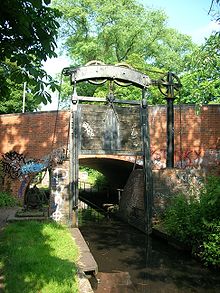 Lifford lane guillotine lock, Kings Norton, Birmingham between the Stratford-upon-Avon Canal and the Worcester and Birmingham Canal
Lifford lane guillotine lock, Kings Norton, Birmingham between the Stratford-upon-Avon Canal and the Worcester and Birmingham Canal
A "stop" lock is a (very) low-rise lock built at the junction of two (rival) canals to prevent water from passing between them.
During the competitive years of the English waterways system, an established canal company would often refuse to allow a connection from a newer, adjacent one. This situation created the Worcester Bar in Birmingham, where goods had to be transshipped between boats on rival canals only feet apart.
Where a junction was built, either because the older canal company saw an advantage in a connection, or where the new company managed to insert a mandatory connection into its Act of Parliament, then the old company would seek to protect (and even enhance) its water supply. Normally, they would specify that, at the junction, the newer canal must be at a higher level than their existing canal. Even though the drop from the newer to the older canal might only be a few inches, the difference in levels still required a lock — called a stop lock, because it was to stop water flowing continuously between the newer canal and the older, lower one. The lock would be under the control of the new company, and the gates would, of course, "point" uphill - towards the newer canal. This would protect the water supply of the newer canal, but would nevertheless "donate" a lockful of water to the older company every time a boat went through. In times of excess water, of course, the lock "bywash" would continuously supply water to the lower canal.
When variable conditions meant that a higher water level in the new canal could not be guaranteed, then the older company would also build a stop lock (under its own control, with gates pointing towards its own canal) which could be closed when the new canal was low. This resulted in a sequential pair of locks, with gates pointing in opposite directions: one example was at Hall Green near Kidsgrove, where the southern terminus of the Macclesfield Canal joined the Hall Green Branch of the earlier Trent and Mersey Canal. The four gate stop lock near Kings Norton Junction, between the Stratford-upon-Avon Canal and the Worcester and Birmingham Canal was replaced in 1914 by a pair of guillotine lock gates which stopped the water flow regardless of which canal was higher. These gates have been permanently open since nationalisation.[11]
Many stop locks were removed or converted to a single gate after nationalisation in 1948. Hall Green stop lock remains, but as a single lock: the extra lock was removed because the lowering of the T&M's summit pound (to improve Harecastle Tunnel's "air draught" — its free height above the water level) meant that the T&M would always be lower than the Macclesfield. The Hall Green Branch is now considered to be an extension of the Macclesfield Canal, which now meets the T&M at Hardings Wood Junction (just short of the Harecastle Tunnel north portal).
It should be noted that the "new canal must be higher" rule is not cast-iron. For instance: the very shallow lock at Autherley Junction, where the 1835 Birmingham and Liverpool canal (now part of the Shropshire Union Canal) met the older (1772) Staffordshire and Worcestershire Canal. The Nicholson guide shows that a boater coming south down the "Shroppie" locks "up" before turning north or south onto the older S & W Canal - so the Shroppie (the newer canal) gains a small lockful of water each time a boat passes. However, the gain is tiny since the level difference is so small that it is sometimes possible to open both gates at once.
Round locks
There are several examples where locks have been built to a round plan, with more than two exits from the lock chamber, each serving a different water level. Thus the lock serves both as a way of changing levels, but also as a junction. The circular plan of the lock allows boats to rotate within the lock, in order to line up with the appropriate exit gate.
The best known example of such a round lock is the Agde Round Lock on the Canal du Midi in France. This both serves as a lock on the main line of the canal, and allows access to the Hérault River.[12]
A second French round lock can be found in the form of the, now disused, Écluse des Lorraines, connecting the Canal latéral à la Loire with the River Allier.[13]
Drop locks
A drop lock allows a short length of canal to be lowered temporarily while a boat passes under an obstruction such as a low bridge. During canal restoration, a drop lock may be mooted where it is impractical or prohibitively expensive to remove or raise a structure that was built after the canal was closed (and where re-routing the canal is not possible).
A drop lock can consist of two conventional lock chambers leading to a sump pound, or a single long chamber incorporating the sump - although the term properly applies only to the second case. As the pounds at either end of the structure are at the same height, the lock can only be emptied either by allowing water to run to waste from the sump to a lower stream or drain, or (less wastefully) by pumping water back up to the canal. Particularly in the two-chamber type, there would be a need for a bypass culvert, to allow water to move along the interrupted pound and so supply locks further down the canal. In the case of the single-chamber type, this can be achieved by keeping the lock full and leaving the gates open while not in use.[14]
While the concept has been suggested in a number of cases, the only example in the world of a drop lock that has actually been constructed is at Dalmuir on the Forth and Clyde Canal in Scotland.[15] This lock, of the single chamber type, was incorporated during the restoration of the canal, to allow the replacement of a swing bridge (on a busy A road) by a fixed bridge, and so answer criticisms that the restoration of the canal would cause frequent interruptions of the heavy road traffic. It can be emptied by pumping - but as this uses a lot of electricity the method used when water supplies are adequate is to drain the lock to a nearby burn. A series of pictures showing the operation of the lock can be seen here.[16] A similar arrangement is due to be built as part of the Droitwich Canal restoration.
Flood locks
A flood lock is to prevent a river from flooding a connected waterway. It is typically installed where a canal leaves a river. At normal river levels, the lock gates are left open, and the height of the canal is allowed to rise and fall with the height of the river.
However, if the river floods beyond a safe limit for the canal, then the gates are closed (and an extra lock created) until the river drops again. Since this is a true lock it is possible for boats to leave the canal for the flooded river despite the difference in water levels (though this is not likely to be wise) or (more sensibly) to allow boats caught out on the flood to gain refuge in the canal.
Note that if the canal is simply a navigation cut connecting two stretches of the same river, the flood lock will be at the upstream end of the cut (the downstream end will have a conventional lock).
Flood locks which have been used only as flood gates (see below) are often incapable of reverting to their former purpose without refurbishment. That is, where only outer gates are ever closed (probably because a waterway is not a true commercial one, and therefore there is no financial imperative for a boat to venture out onto a flooded river) inner gates soon suffer from lack of maintenance. A good example is on the Calder and Hebble Navigation, where structures referred to in the boating guides as "Flood Locks" are clearly only capable of being used for flood-prevention, not for "penning" boats to or from the river in flood.
Flood gates
Main article: Flood gateA flood gate or "stop gate" is the cheaper equivalent of a flood lock. Only one set of gates exist, and so when the river is higher than the canal, the gates are closed and navigation ceases. These are quite common in the French inland waterways system. Flood gates may also be used to sub-divide long canal pounds or protect, in case of bank collapse, the surrounding area if this is lower than the water level of the canal. They are commonly found at the ends of long embankments and at aqueducts. These gates are often overlooked because they lack balance beams and are only a little higher than normal canal level.
Bi-directional gates and locks
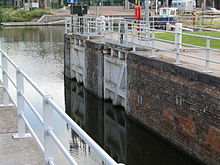 Bi-directional gates at one chamber end of a tidal lock (located in Veurne on the canal Nieuwpoort - Duinkerke)
Bi-directional gates at one chamber end of a tidal lock (located in Veurne on the canal Nieuwpoort - Duinkerke)
Where a lock is tidal (i.e. one side of the lock has water whose level varies with the tide) or where a canal meets a river whose level may vary, the water on the tidal or river side (the "downstream" side) may rise above the water on the normal "upper" side. The "upstream" pointing doors will then fail to do their job, and will simply drift open. To prevent water flowing the wrong way through the lock, there will need to be at least one set of gates pointing in the "wrong" direction. If it is desirable that boats can use the lock in these circumstances, then there needs to be a full set of gates pointing towards the tidal or river side. The usual method is to have gates pointing in opposite directions at both ends of the chamber (alternatively, the "paired stop lock" arrangement of two separate sequential locks pointing in opposite directions would work here — but would require an extra chamber). If navigation is not required (or impossible) at one "extreme" (e.g. allow navigation above mid-tide, but just prevent the canal emptying at low tide) then it is only necessary to have one set of bi-directional gates.
A sea lock is one that connects a canal or river directly with an estuary or ocean. All sea locks are tidal.
Tidal locks
A tidal lock is generally any lock that connects tidal with non-tidal water. This includes a lock between a tidal river and the non-tidal reaches, or between a tidal river and a canal, or a sea lock. However, the term usually refers specifically to a lock whose method of operation is affected by the state of the tide. Examples:
- A canal joining a river whose levels are always lower than the canal. All that is needed is an ordinary lock, with the gates pointing up the canal. The lock is used normally so long as the tide is high enough to float boats through the lower gates. If near low tide the lock becomes unusable, then the gates can be barred (and simply become a "reverse flood gate", holding water in the canal). This arrangement also applies to some sea locks (e.g. Bude Canal).
- A canal joining a river which is normally below it, but which can rise above it (at very high tides, or after heavy rain). One pair of gates can be made bidirectional, i.e. the inward-pointing gates would be supplemented by a pair pointing out to the river. When the river is higher than the canal, the normal gates would just drift open, but the additional pair of gates can be closed to protect the canal, and prevent navigation to the river. In effect, we have simply added a flood gate.
- As above, but where it is safe to navigate even when the river is higher than the canal. The lock will be fully bidirectional (two pairs of oppositely pointing gates at each end) to allow boats to pass at any normal river levels. At extreme low or high tides unsuitable for navigation, the appropriate sets of gates are barred to prevent passage.
Very large locks
The world's largest lock is the Berendrecht Lock, giving access to the Port of Antwerp in Belgium. The lock is 500 metres (1,640 ft) long, and 68 metres (223 ft) wide and drops 13.5 m, and has four sliding lock gates. The size of locks cannot be compared without considering the difference in water level that they are designed to operate under. For example, the Bollène lock on the River Rhône has a fall of at least 23 m and the Oskemen Lock on the Irtysh River in Kazakhstan has a drop of 42 m.[17] The total volume of water to be considered in any lock equals the product of its length, breadth and the difference in water levels. Lock staircases are used in an attempt to reduce the total volume of water required in relation to the amount of useful work done. The useful work done relates to the weight of the vessel and the height it is lifted. When a vessel is lowered the consumption of potential energy of the water consumed is considered. An alternative to locks is a boat lift; facilities of this type, e.g. the Anderton boat lift or the Strépy-Thieu boat lift in Belgium, do not rely on the consumption of water as the primary power source, are powered by motors and are designed to consume a minimum amount of water.
The Welland Canal is a ship canal in Canada, that runs 42 km (26 mi) from Port Colborne, Ontario on Lake Erie to Port Weller, Ontario on Lake Ontario. A major part of the St. Lawrence Seaway, the canal allows ships to avoid Niagara Falls by traversing the Niagara Escarpment.
Approximately 40,000,000 tonnes of cargo is carried through the Welland Canal annually by over 3,000 ocean and lake vessels. It allows goods from notable cities like Toronto, Detroit, Cleveland and Chicago along with other heavily industrialized areas of the United States and Canada to be shipped via ocean-going vessels for international delivery.
The completion of the Welland Canal made the Trent-Severn Waterway (which links Lake Ontario with Lake Huron) all but obsolete as a commercial traffic route for Great Lakes navigation.
The canal's Lake Erie (southern) terminus, at Port Colborne, is 99.5 m (326.5 feet) higher in elevation than the Lake Ontario (northern) terminus at Port Weller. The canal comprises eight lift locks, each 24.4 m (80 ft) wide by 233.5 m (766 ft) long. Due to the Garden City Skyway, the maximum ship height allowed is 35.5 m (116.5 ft). All other crossings are movable bridges (lift or Bascule) or tunnels. The maximum permissible vessel length is 225.5 m (740 ft). It takes ships an average of 11 hours to traverse the canal's length.
The 29 locks on the Mississippi River are typically 600 feet (180 m) long while tug and barge combinations are as much as 1,200 feet (360 m) long consisting of as many as 15 barges and one tug. In these cases, some of the barges are locked through, using partially opened lock valves to create a current to pull the un-powered barges out of the lock where they are tied up to wait for the rest of the barges and the tug to pass through the lock. It can take as much as an hour and a half to pass the lock.
Hiram M. Chittenden Locks
In November 2004 one of the Hiram M. Chittenden Locks (better known locally as the "Ballard Locks" in reference to the Seattle neighborhood they are located in) was emptied for maintenance, as seen in the pictures below. This provided an opportunity to visualize how a lock works without the water obscuring the bottom of the lock. For reference, the picture far left shows the lock in operation, with a tug and a barge (loaded with sand and gravel) waiting for the gates to open. In the bottom left corner of the picture may be seen the cut-out in the side wall that contains the gate when open.
The lock has three pairs of gates, one pair at each end and one pair in the middle so that half the length of the lock can be used when the whole length is not required, thus saving water. The barely visible person walking along the bottom of the lock in the second picture gives an indication of the vast size of this lock. In both pictures of the end gates, the string of penstock openings are visible along the sides at the bottom. The water entering and leaving the lock flows by gravity through these openings. It requires around 15 minutes to fill or empty the lock.
-
Hiram M. Chittenden Locks: tug and barge in lock when full.
History and development
Dams and weirs
In ancient times river transport was common, but rivers were often too shallow to carry anything but the smallest boats. Ancient people discovered that rivers could be made to carry larger boats by making dams to raise the water level. The water behind the dam deepened until it spilled over the top creating a weir. The water was then deep enough to carry larger boats. This dam building was repeated along the river, until there were "steps" of deep water.
Flash locks
The development of dams and weirs created the problem of how to get the boats between these "steps" of water. An early and crude way of doing this was by means of a flash lock. A flash lock consisted essentially of a small opening in the dam, which could be quickly opened and closed. On the Thames in England, this was closed with vertical posts (known as rimers) against which boards were placed to block the gap.
When the gap was opened, a torrent of water would spill out, carrying a "downstream" boat with it, or allowing an "upstream" boat to be manhauled or winched through against the flow. When the boat was through, the opening would be quickly closed again. The "gate" could also be opened to release a 'flash' downstream to enable grounded boats to get off shoals, hence the name.
This system was used extensively in Ancient China and in many other parts of the world. But this method was dangerous and many boats were sunk by the torrent of water. Since this system necessarily involved lowering the level in the pound, it was not popular with millers who depended on a full head of water to operate their equipment. This led to constant battles, both legal and physical, between the navigation and milling interests, with rivers being closed to navigation if there was any shortage of water. It was mainly this conflict which led to the adoption of the pound lock in medieval China, as this means that relatively little water is consumed by navigation.
Staunch
A more sophisticated device was the staunch or water gate, consisting of a gate (or pair of mitred gates) which could be closed (and held shut by water pressure) when the river was low, in order to float vessels over upstream shallows at times of low water. However, the whole upstream head of water had to be drained (by some auxiliary method approaching modern sluices) before the a boat could pass. Accordingly they were not used where the obstacle to be passed was a mill weir.
Pound lock
The natural extension of the Staunch was to provide an upper gate (or pair of gates) to form an intermediate "pound" which was all that need be emptied when a boat passed through. This type of lock, called a pound lock was known in Imperial China, Medieval Europe, and possibly the Romans as indirect evidence suggests.[18] Note the change in terminology: on a British Canal, it is the section of canal between locks that is called a pound.
Turf-sided lock
A turf-sided lock is an early form of canal lock design that uses earth banks to form the lock chamber, subsequently attracting grasses and other vegetation, instead of the now more familiar and widespread brick, stone, or concrete lock wall constructions. This early lock design was most often used on river navigations in the early 1700s before the advent of canals. The sides of the turf-lock are sloping so, when full, the lock is quite wide. Consequently, this type of lock needs more water to operate than vertical-sided brick- or stone-walled locks. On British canals and waterways most turf-sided locks have been subsequently rebuilt in brick or stone, and so only a few good examples survive, such as at Garston Lock, and Monkey Marsh Lock, on the Kennet and Avon Canal.[19]
Use of water
The main problem caused by locks is that, each time a lock goes through one fill-empty cycle, a lockful of water (tens of thousands up to millions of litres) is released to the lower pound. In more simplistic terms, on a canal where only one boat will fit into a lock, a boat travelling from the summit pound to the lowest pound is accompanied on its journey by one 'personal' lockful of water. A boat going the other way also transfers a lockful of water from the summit pound to the lowest pound. To prevent the canal from running dry, some method must be used to ensure that the water supply at the canal summit is constantly replenished at the rate that the water is being drained downwards. This is, of course much more of a problem on an artificial canal crossing a watershed than on a river navigation.
Design
When planning a canal, the designer will attempt to build a summit level with a large reservoir, or one supplied by an artificial watercourse from a distant source, or one as long as possible (to act as its own reservoir) or which cuts across as many springs or rivers as possible (or all of these).
Pumping
Where it is clear that natural supply will not be sufficient to replenish the summit level at the rate that water will be used (or to allow for unexpected periods of drought) the designer may plan for water to be back-pumped back up to the summit from lower down. Such remedies may of course be installed later, when poor planning becomes apparent, or when there is an unforeseeable increase in traffic or dearth of rain. On a smaller scale, some local pumping may be required at particular points (water is continually recycled through some locks on the Kennet and Avon canal).
Water saving basins
A way of reducing the water used by a lock is to give it one or multiple reservoirs, whose levels are intermediate between the upper and lower pounds. These reservoirs can store the water drained from the lock as a boat descends, and release it to fill the next time a boat ascends. This saves half the amount of water lost downhill in each fill-empty cycle. Generally these reservoirs are called "saving basins".
For example the Hindenburg-lock (in Hannover, Germany, built 1919-1928) has two lock chambers of 225 m length, each of which would use 42,000 m³ of water for a full locking cycle. Due to the use of 10 water saving basins, only 10,500 m³ of water are used. A more recent example is the Rhine–Main–Danube Canal with 13 saving locks out of a total of 16 locks.
Water saving basins are incorporated in proposals to augment the capacity of the Panama Canal, but the scheme is controversial because the mixing of salt and fresh water in the basins will allow brackish water into Gatun Lake, a source of drinking water and a wildlife reserve.[20][21]
On English canals, these reservoirs are called "side ponds". They were installed on the Grand Union Canal and the Coventry Canal, among others. They are now out of use, and in some cases have been filled in, because British Waterways considered that it was too easy to misuse them and flood the surrounding area. On some flights of locks with short intermediate pounds, the pounds are extended sideways — in effect to provide a reservoir to ensure that the pound does not run dry (in case, for instance, the lock below leaks more than the lock above). These extended intermediate pounds are sometimes confused with side ponds.
Alternatives
As well as the "static" approaches mentioned earlier (various types of contouring, excavating, and spanning), there were many ingenious "dynamic" solutions, mostly variations on the boat lift or the inclined plane. These tend to be more expensive to install and operate, but offer faster transit and waste less water.
Inclined plane
An inclined plane consists of a cradle (to hold a barge) or caisson (a box full of water in which a barge can float) which moves on rails sideways up a slope from one waterway to the other. Since the box is "wet" (filled with water), Archimedes' principle ensures that the caisson always weighs the same, regardless of the size of boat being carried (or even if it contains only water). This makes for easy counterbalancing by a fixed weight or by a second caisson. The motive power may be steam or hydraulic, or may come from overbalancing the top caisson with extra water from the upper waterway.
There are no working waterway inclined planes in the UK at the moment, but the remains of a famous one can be seen at Foxton in Leicestershire on the Leicester arm of the Grand Union Canal. The plane enabled wide-beam boats to bypass the flight of ten narrow locks, but failure to make improvements at the other end of the arm and high running costs led to its early demise.[22] There are plans to restore it, and some funding has been obtained.[23]
Marine railway
A marine railway is similar to a canal inclined plane in that it moves boats up or down a slope on rails. However, the vessel is carried "dry" (in a carrying frame, or cradle) rather than in a water-filled caisson. The principle is based on the patent slip, used for hauling vessels out of the water for maintenance.
In operation, a boat is navigated into the carrying frame, which has been lowered into the water. The boat is secured to the cradle, possibly by raising slings under the hull using hydraulics, and the cradle is hauled out of the water and up the hill with a cable. At the top of the slope, the cradle is lowered into the upper waterway, and the boat released. As the boat is not floating, Archimedes' principle does not apply, so the weight lifted or lowered by the device varies - making counterbalancing (by dead weights or a second boat carriage) more difficult.
In some locations, notably the Big Chute Marine Railway on the Trent-Severn Waterway, in Ontario, Canada, a marine railway was installed as a temporary measure at the planned site of a flight of conventional locks. In this and several other cases, the locks were never built, and the marine railway continued to serve on a permanent basis.
Boat lift
The Falkirk Wheel, the world's first rotating boat lift, acts as the centrepiece of the restoration of the Forth and Clyde and Union Canals. The spectacular "Wheel" presents the 21st century's solution to replacing a flight of locks which formerly connected the canals and which were filled-in in 1930. The Falkirk Wheel was the winning design in a competition to design a new lock. Visitors can now take a boat trip on the Wheel and be lifted over 100 feet (30 m) in a few minutes compared to the time it took when the original lock staircase operated.
The Victorian Anderton Boat Lift, the world's first vertical boat lift, linking the Trent and Mersey Canal and the River Weaver in Cheshire, has recently been restored. The world's highest boat lift of Strépy-Thieu in Belgium raises or lowers 1,350 tonnes boats by 73.15 metres.
Another famous derivative is the Peterborough lift lock which is a boat lift located on the Trent Canal in the city of Peterborough, Ontario, Canada and is Lock 21 on the Trent-Severn Waterway.
The dual lifts are the highest hydraulic boat lifts in the world, rising 19.8 m (65 ft). This was a considerable accomplishment when conventional locks usually only had a 2 m (7 ft) rise. Each lift has a capacity of 1,300 tonnes.
The basins are 140 feet (43 m) long, 33 feet (10 m) wide and 9 feet 10 inches (3.0 m) deep. The vertical distance lifted is 65 feet (20 m). The Trent-Severn has another similar lift lock at Kirkfield, with basins of the same dimension, but which lifts over a smaller vertical distance.
Caisson lock
Around 1800 the use of caisson locks was proposed by Robert Weldon for the Somerset Coal Canal in England. In this underwater lift, the chamber was 80 ft long and 60 ft (18 m) deep and contained a completely enclosed wooden box big enough to take a barge. This box moved up and down in the 60 ft (18.2 m) deep pool of water. Apart from inevitable leakage, the water never left the chamber, and using the lock wasted no water. Instead, the boat entered the box and was sealed in by the door closing behind it, and the box itself was moved up or down through the water. When the box was at the bottom of the chamber, it was under almost 60 feet (18 m) of water – at a pressure of three atmospheres, in total. One of these "locks" was built and demonstrated to the Prince Regent (later George IV), but it had various engineering problems and the design was not put into use on the Coal Canal.[24][25] However, in about 1817 the Regents Canal Company built one of these locks at the site of the present-day Camden Lock, north London. Here the motivation was, again, water supply problems. Even though the change in level is much lower than that would have been the case in Somerset, the system was soon replaced by conventional locks.[26] No commercially successful example has ever been built.
Diagonal lock
This new concept in lock design has yet to be installed on any waterway. The proposal is for a long tube of reinforced concrete, of a size to accommodate the boats being lifted, to be built on the slope between the upper and lower levels. The bottom of the tube is sealed with a strong watertight door, but there is a single pair of conventional lock gates at the top, installed a boat's length from the far wall of the tube. The change in level is achieved by filling the tube with water from the top pound, or by draining. The vessel floats on the surface of the water, with a guide float or pontoon, shaped to fit the tube, floating alongside to keep it clear of the walls. Side ponds, piped from the main tube, are incorporated to save water. In replacing a traditional flight or staircase of locks, a considerable time saving is anticipated. It differs from the discredited caisson lock design in that the boat does not have to be carried in a submerged chamber.
The "Diagonal Lock Advisory Group" has identified several sites in Britain where the new design could be installed, either on new waterways or canals under restoration.[27] Projects under consideration include the restoration of the Lancaster Canal to Kendal and the proposed new branch of the Grand Union Canal between Bedford and Milton Keynes
A combined system - the Three Gorges Dam
At the Three Gorges Dam on the Yangtze River (Chang Jiang) in China there are two stair-steps of five large ship locks (each 300 m long and 35 m wide) for ten-thousand-tonne ships. In addition to this there will be a boat lift (a large elevator) capable of moving a three thousand ton ship vertically in one motion. The locks and the boat lift provide a total lift of up to 113 metres.
Ship sizes named after locks
Locks restrict the maximum size of ship able to navigate a waterway, and some key canals have given rise to the name of standard ship sizes, such as the Panamax and the Seawaymax.
See also
References
- ^ Needham, Volume 4, Part 3, 350-351
- ^ a b Temple, Robert (2007). The Genius of China: 3,000 Years of Science, Discovery, and Invention (3rd edition). London: André Deutsch, pp. 218-9. ISBN 9780233002026.
- ^ Needham, Volume 4, Part 3, 351-352.
- ^ a b Needham, Volume 4, Part 3, 351.
- ^ a b Needham, Volume 4, Part 3, 357.
- ^ Needham, Volume 4, Part 3, 358.
- ^ "Second Lock". Images of England. http://www.imagesofengland.org.uk/details/default.aspx?id=442716. Retrieved 4 September 2006.
- ^ Allsop, Niall (1987). The Kennet & Avon Canal. Bath: Millstream Book. ISBN 0-948975-15-6.
- ^ "Reach". Oxford English Dictionary (Second ed.). Oxford, England: Oxford University Press. 1989. "...the portion of a canal between two locks, having a uniform level"
- ^ L.T.C. Rolt (1973/1994). From Sea to Sea. Euromapping, Seyssinet, France.
- ^ Birmingham's Canals, Ray Shill, 1999, 2002, ISBN 0-7509-2077-7
- ^ "Canal du Midi". Afloat in France. grehanman guides. http://www.tagweb.co.uk/french-waterways/0-waterways/midi.html. Retrieved 2010-11-23.
- ^ "Canal lateral a la Loire". Afloat in France. grehanman guides. http://www.tagweb.co.uk/french-waterways/0-waterways/loire-lateral.html. Retrieved 2010-11-24.
- ^ "Dalmuir Drop Lock". http://www.gentles.info/link/Drop_Lock/Drop_Lock.htm. Retrieved 22 October 2007.
- ^ voltimum. "Mitsubishi helps breath new life into important canal routes". http://www.voltimum.co.uk/news/496/infopro/Mitsubishi-helps-breath-new-life-into-important-canal-routes-.html. Retrieved 23 October 2007.
- ^ "Clydebank Drop Lock". Gentles.info. http://www.gentles.info/link/Drop_Lock/Drop_Lock.htm. Retrieved 2011-08-05.
- ^ "Latest". Waterways World. http://www.waterwaysworld.com/latest.cgi?month=012008&start=20. Retrieved 2011-08-05.
- ^ Frank Gardner Moore "Three Canal Projects, Roman and Byzantine." American Journal of Archaeology, 54, (1950), 97-111 (99)
- ^ "British Waterways 'Waterscape' website". http://www.waterscape.com/services-directory/1418/monkey-marsh-lock. Retrieved 11 January 2011.
- ^ "Study of Additional Combinations of Lock Water Saving Basins for Proposed Post-Panamax Locks at the Panama Canal". Autoridad del Canal de Panamá. 23 April 2004. http://www.pancanal.com/esp/plan/estudios/0128-exec.pdf. Retrieved 13 July 2008.
- ^ Jackson, Eric (17 September 2006). "Environmental defense of Torrijos". The Panama News. http://www.thepanamanews.com/pn/v_12/issue_18/news_01.html. Retrieved 13 July 2008.
- ^ Nicholson Waterways Guide, Volume 3, Harper Collins Publishers, ISBN 0-00-713666-8
- ^ "Foxton Inclined Plane Trust: Restoration". Fipt.org.uk. http://www.fipt.org.uk/lift.html. Retrieved 2011-08-05.
- ^ "The Somerset Coal Canal". Bath Royal Literary and Scientific Institution. http://www.brlsi.org/proceed03/transport200201.htm. Retrieved 6 October 2006.
- ^ "History of the Caisson Lock On the Somersetshire Coal Canal". The Somersetshire Coal Canal (Society). http://rtjhomepages.users.btopenworld.com/caishist.html. Retrieved 6 October 2006.
- ^ Faulkner, Alan (2005): The Regent’s Canal: London’s Hidden Waterway. Waterways World Ltd. ISBN 1-870002-59-8.
- ^ Fogarty, Terry (2008). "Diagonal Lock How It Works". http://www.diagonallock.org/about.htm. Retrieved 18 June 2008
External links
- Deepest Canal Locks in England
- Interactive simulation of lock operation – this demonstration shows guillotine-type gates for clarity
- Interactive lock game for students with single and double flight locks and lesson plans
Categories:- Canals
- Rivers
- Water transport infrastructure
- Locks (water transport)
- Types of gates
Wikimedia Foundation. 2010.


